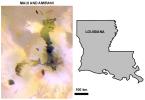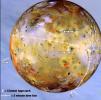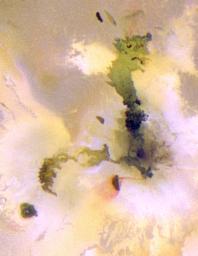This pair of volcanic features on Jupiter's moon Io represents the longest active lava flow known to exist in our solar system. This image, one of the highest resolution pictures ever taken of Io, was obtained by NASA s Galileo spacecraft on July 3, 1999. That was during Galileo's closest pass by Io since it entered orbit around Jupiter in December 1995.
The volcanic features, Amirani (right side of image) and Maui (to the left, just below the center of the image), were originally thought to be two separate volcanoes. However, Galileo images have shown that Maui is actually the active front of a lava flow that has extended westward from a vent at Amirani for more than 250 kilometers (160 miles). Observations by Galileo's near-infrared mapping spectrometer show a hotspot at Maui, so the lava must still be flowing. Other flows extend northward from the Amirani vent.
White plume deposits encircle the Amirani vent and are likely to be sulfur dioxide-rich vapors that have escaped at the vent, frozen and then snowed out onto the ground. The red deposits from the dark spot southwest of the Amirani vent appear to have been blown away from the stronger Amirani plume. The red material may be produced by a form of sulfur.
Amirani-Maui is more than 250 kilometers (160 miles) long. Such gigantic lava flows are found on Venus, the Earth, the Moon, and Mars. Massive eruptions on the Earth coincide with the times of major extinction events.
The image, in false color, uses the near-infrared, green and violet filters (slightly more than the visible range) of the spacecraft's camera, processed to enhance subtle color variations. North is to the top of the picture, and the Sun illuminates the surface from almost directly behind the spacecraft. This illumination is good for imaging color variations, but poor for imaging topographic shading. The image is centered at 23 degrees north latitude and 118 degrees west longitude. The images were taken at a distance of about 130,000 kilometers (81,000 miles) by Galileo's onboard solid state imaging camera and have a resolution of 1.3 kilometers or 0.8 miles per picture element.
 | Click on this image to view
a context image of Io's
volcano Amirani.
(MRPS95335) |
 | Click on this image to view
Galileo's flight plan for I24 & I25.
(MRPS95336) |
The Jet Propulsion Laboratory, Pasadena, CA manages the Galileo mission for NASA's Office of Space Science, Washington, DC. JPL is a division of Caltech.
This image and other images and data received from Galileo are posted on the World Wide Web, on the Galileo mission home page at http://solarsystem.nasa.gov/galileo/. Background information and educational context for the images can be found at http://www.jpl.nasa.gov/galileo/sepo.

 Planetary Data System
Planetary Data System














